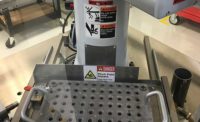Although fabricated metal parts are found in all types of products, not all fabricators are open to making multiple types of metal parts. Lancaster, SC-based Industrial Manufacturing Services (IMS), for example, specializes in producing components for OEMs in the heavy machinery industry.
Founded in the late 1990s, the company is ISO 9001:2015 certified and employs about 80 people. Among the company’s most important workers are those that perform manual welding.
“Ten to 15 years ago, recruiting welders was a lot easier, and labor was cheaper,” says Warren Earl, vice president at IMS. “Today, there is a gap in the skill levels of welders, [and they] are harder to hire.”
This reality made it increasingly difficult for the company to meet its customers’ growing demand for parts. Eventually, IMS purchased four traditional six-axis robots to maintain a high level of production, as well as ensure repeatability among the more-than-700 different parts IMS currently makes.
However, the robots were complicated to set up and program, notes Matt Blowers, a manufacturing engineer at IMS. He says a three-person team was required to handle all of the robots’ programming and inner workings.
Rather than buy a fifth robot, the company contacted Hirebotics and inquired about its welding cobots. Hirebotics recommended its Cobot Welder (CW) package, which includes a Universal Robots UR10e cobot (with 51-inch reach), a Miller Invision pulsed welder and S74 feeder, a Tregaskiss MIG welding gun, a Siegmund welding cart, an operator panel with emergency stop, and the Hirebotics' Smart Puck for software-free teaching.
Initially, IMS workers were skeptical about the CW’s claimed ease of use, due to their past experience with other cobots that were difficult to program. This skepticism soon dissipated after working with the CW.
“We had welders learn how to use the welder in about half an hour,” says Blowers. “[Its simplicity] enables non-welders to operate the machine without needing to learn programming language or go to a school.”
Justin Payne, a manufacturing engineer at IMS, says it typically takes him an hour to program a traditional robot, but just over four minutes to program the CW. He adds that the CW is also much more user friendly.
“If you have several CWs, you can transfer a program from one machine to another by simply copying and pasting,” explains Payne. “You don’t have to rewrite things.”
Payne also likes the benefits of the CW app he has on his cell phone. The app enables him to solve welding problems on the fly, as well as address, in real time, any questions the welding team may have about setting up a specific job.
“On the CW, it takes five to 10 minutes to set up everything, [whereas] traditional robot programming can take up to two hours,” adds Blowers. “It is [also] easier to [weld] new parts, and you can flip them within 10 to 20 minutes. With other robots, it could take a couple of hours to get just one done.”
Most importantly, the CW has enabled IMS to take on more welding jobs, both simple and complex. Now all menial welding tasks are performed by the CW, so the company’s skilled welders can tackle more complicated work for greater job satisfaction.
For more information on welding cobots, call 615-800-2684 or visit www.hirebotics.com.





